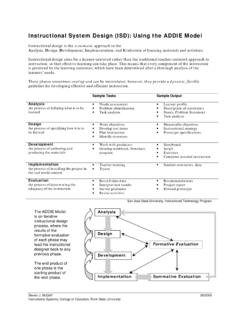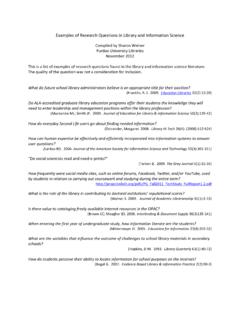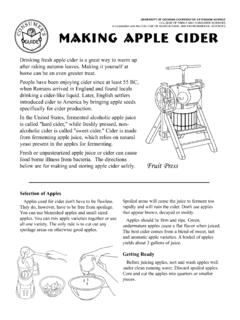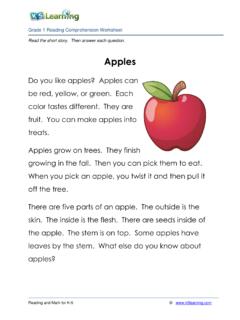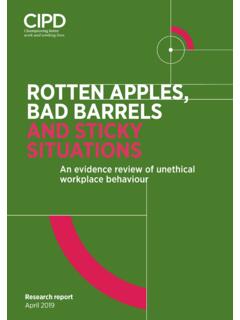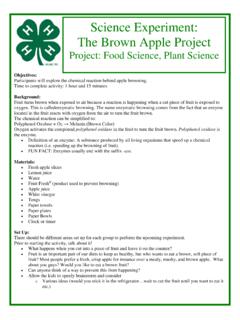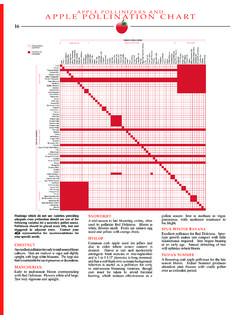Transcription of How READ - Purdue University
1 How READ. to Scientific a Paper Main Menu How to Read a Scientific Paper Why? Why it's important for you to read the literature. How? How to make reading scientific papers as painless as possible. Anatomy Everything you ever wanted to know why it's there and what it's good for. Click the buttons to navigate. Credits Main Menu How to Read a Scientific Paper Why? Does your professor just want to ruin your life? Or is there a good reason to read the literature? Credits Main Menu How to Read a Scientific Paper From Soup to Nuts How? How to make reading scientific papers as painless as possible. Credits Main Menu How to Read a Scientific Paper The Scientific Paper Exposed Everything you ever wanted to know . Anatomy why it's there and what it's good for. Credits Main Menu Why Read? It's Current! Textbooks can be years out of date by the time they are published.
2 Journals tell you what is happening . RIGHT NOW! Credits Main Menu Why Read? It's Current! It Can Be Replicated! Popular articles and books give you general information and results. Scholarly journals give you enough information that you could do the experiment yourself. You can verify the research to see if you get the same results. Credits Main Menu Why Read? It's Current! It Can Be Replicated! It Has Actual Data! If you need to know exact results or properties for your own research . Articles include actual data, uncertainties, conditions of the experiment, and much more. Credits Main Menu Why Read? It's Current! It Can Be Replicated! It Has Actual Data! You Can Evaluate The Conclusions! Do You Believe It Or Not? Articles provide the authors' explanation of their results and conclusions. You can see their assumptions and determine whether you believe them or not.
3 Credits Main Menu Why Read? So, There You Have It . Current Has Raw Data It's the most up to date stuff Save time use their results Replicable Shows Logic I can redo the experiment Do you believe it or not? myself All the Reasons to Read Scientific Papers Credits Main Menu How to Read a Scientific Paper From Soup to Nuts How? How to make reading scientific papers as painless as possible. Credits Main Menu How To Read . STOP. Don't Read Straight Through! It's like walking through quicksand! Credits Main Menu How To Read . Before you read, you need the right equipment . A Scientific Dictionary: Look up terms you don't know. Try , for an online dictionary. Your handy-dandy notebook: Make notes so you'll remember your insights. Your friends and colleagues: Explaining to others will help you understand the paper yourself. Credits Main Menu How To Read.
4 Okay, all packed? Credits Then, let's go! Main Menu How To Read . Okay, let's start our trip to understanding scientific papers! In this section, we will read sections of a paper in the order that makes for faster, more efficient comprehension than reading the paper straight through. Credits Main Menu How To Read . Okay, let's start out trip to understanding scientific papers! First stop, The Abstract Credits Main Menu How To Read Abstract: We examined several apples'. color. Although most are red, some are not. Abstract: Tells you briefly what experiment was done and what was found. Question: What specific results are mentioned? Are they relevant? Credits Main Menu How To Read . Discussion: Since we found one yellow apple and two green apples, it must be true that all apples are not red. We concur with G. smith's findings. Discussion: Summarizes important results, gives reasons for conclusions based on results.
5 Question: Do you agree with the logic of the conclusions? Are these results useful to you? Credits Main Menu How To Read Introduction: An age-old question is: are all apples red? Macintosh (1993). thought so. G. Smith (1999) begs to differ. We hope to resolve this issue once and for all. Introduction: Explains motivation and importance of research, provides background information. Question: Do you understand background info? Do you need to look up references for more info? Credits Main Menu Results: How To Read . We found four red apples, one green apple , and two yellow apples. See Figure 1. Results: Provides the raw data you might need for your own research. Figures and tables provide the data in a compact format for easy viewing. Question: For figures, do you understand what the axes mean? What units are used? Does the curve make sense?
6 Credits Main Menu How To Read . Congratulations! You've reached an understanding of the paper. You can see whether the paper is relevant to your work and know where the data and conclusions are hidden. Credits Main Menu How to Read a Scientific Paper The Scientific Paper Exposed Everything you ever wanted to know . Anatomy why it's there and what it's good for. Credits Main Menu Anatomy of a Scientific Paper Results: We found four red apples, one green Are All Apples Red? apple , and two yellow apples. See Figure 1. by 5. Ida Cortland 0. Abstract: We examined several apples' color. Figure 1. Although most are red, some are not. Introduction: Discussion: An age-old question is: are all apples Since we found one yellow apple and red? Macintosh (1993) thought so. G. two green apples, it must be true that all Smith (1999) begs to differ.
7 We hope to apples are not red. We concur with G. resolve this issue once and for all. Smith's findings. Methods: References: We went to the local grocery store and Macintosh (1993) Journal of Fruit Science. 4(3): 121-135. bought one of every apple they had. We Smith, G. (1999) apple Technology Today. 7(3): took them home and looked at them. 4-8. Pomes and You, Volume 3, Issue 4 (2003) Credits Main Menu The Abstract Gives you a brief overview of what the Abstract: paper is all about. We examined several apples'. Explains why the authors did the color. Although most are red, experiment, how they did it, and what some are not. they found out. Ask yourself, are the findings relevant to the question you have? It's very important to read abstracts to help you decide whether to read the whole paper or not. Abstracts are available in many indexes to the journal literature, so you don't even need to find the actual article to determine whether it might be interesting to read.
8 Credits Main Menu The Introduction Introduction: An age-old question is: are Provides the motivation for doing the experiment, explaining Why did they all apples red? Macintosh bother'? (1993) thought so. G. Smith (1999) begs to differ. We hope to resolve this issue once and for all. It explains prior research, and what the accepted understanding of the field is. In this case, there is a dispute between Macintosh and Smith, and this paper seeks to settle the dispute. Credits Main Menu Methods Gives details on how the experiment Methods: was set up and carried out. We went to the local grocery store and bought one of every Should explain well enough that you apple they had. We took them could replicate the experiment yourself, if you wanted to. home and looked at them. Often the hardest section to understand, since it contains specialized techniques.
9 Skip this section until last. When reading, skim and try to pick out basic methods used. Don't worry that much about the details that's for grad school. Ask you instructor or consult a scientific encyclopedia or textbook if you don't understand the concepts of the technique. Credits Main Menu Results Table 1: 5 apple Colors Results: 4. Brand Color 3. We found four red apples, 2. Gala Light Red IdaRed Red one green apple , and two 1 Macoun Red 0. yellow apples. Red Yellow Green Fuji Yellow . Figure 1. This section provides the data the authors use to reach their conclusions. Figures are often included to make the data more compact and intuitive, and Tables organize data in one place for easier reading. Understanding Figures and Tables is EXTREMELY important in understanding a paper. For figures, make sure you understand what quantities are on the axes.
10 Are they linear or logarithmic? What units are plotted? Credits Main Menu Discussion/Analysis/Conclusion (This section may be named any of these things). Discussion: This is where the author connects the Since we found one yellow dots explaining what the data means, apple and two green apples, it and why they support the conclusion. must be true that all apples are not red. We concur with G. Smith's findings. Compare your own conclusions about the data with the authors' analysis. When skimming the paper for the first time, after reading the abstract read the concluding section. It gives more detail on the specific results that were found, and helps you determine whether the paper is relevant to your research question. Credits Main Menu References/Bibliography Provides a list of resources References: quoted or referenced by Macintosh (1993) Journal of Fruit Science.
